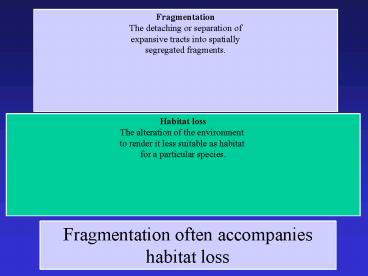Fragmentation - PowerPoint PPT Presentation
1 / 25
Title:
Fragmentation
Description:
and landscapes with sites isolated. by clearcuts or very young stands. ... Landscapes are a constantly. shifting mosaic of habitat patches. of varying ... – PowerPoint PPT presentation
Number of Views:24
Avg rating:3.0/5.0
Title: Fragmentation
1
Fragmentation The detaching or separation
of expansive tracts into spatially segregated
fragments.
Habitat loss The alteration of the environment
to render it less suitable as habitat for a
particular species.
Fragmentation often accompanies habitat loss
2
As with grain, it is important to view
fragmentation from an organism- centered
perspective what is fragmented to one species
may not be to another
3
Concerns about fragmentation
Effects of reduction in area of
remaining fragments (habitat loss)
Effects of increasing isolation of
patches (fragmentation)
Effects of increasing disturbance from
surrounding area (edge effects)
4
Connectivity
The degree to which ecological systems are
spatially oriented in a manner that allows flow
of energy, nutrients, water, disturbance, or
organisms among them.
5
Percolation theory
Based on fluid dynamics and material science
when is movement of a fluids through a substrate
impeded
?
?
6
Percolation theory
Simplest models assume two habitat types
permeable (allows movement) and impermeable (does
not allow movement)
?
?
7
Percolation theory
Response to increasing amount of
non-permeable habitat is non-linear after
reaching a threshold connectivity
diminishes dramatically
8
Percolation theory
With simple models, threshold occurs
when permeable habitat declines to 59 of the
landscape, but leap-frogging impermeable
patches drive this value lower
9
Percolation theory
If actual landscapes behave in this
manner, landscapes can tolerate a certain amount
of fragmentation with no ill effects, then
dramatic effects may occur with small additional
changes in habitat
10
Two basic approaches to providing connectivity in
a landscape 1. Corridors 2. Permeable
matrix
11
Corridor a linear patch of habitat connecting
two other patches of similar habitat
Advantages
Logical
Habitat known to be suitable
12
Corridor a linear habitat patch of habitat
connecting two other patches of similar habitat
Disadvantages
Too much connectivity may spread negative
consequences among patches
Lots of edge
Unknown effectiveness
What is a corridor to one species may be a
barrier to another
Costly
13
Riparian areas as corridors?
Only a partial solution dont always connect the
right forest types.
14
Riparian areas as corridors?
Some species are upland associates
15
Use of unlogged habitat corridors
Hallett and Mech 2001 Conservation Biology
15467-474.
16
Use of unlogged habitat corridors
Hallett and Mech 2001 Conservation Biology
15467-474.
Compared genetic differentiation in contiguous
landscapes, landscapes with sites connected by
corridors, and landscapes with sites isolated by
clearcuts or very young stands.
17
Use of unlogged habitat corridors
Hallett and Mech 2001 Conservation Biology
15467-474.
Genetic differentiation for deer mice similar in
all landscape types
18
Use of unlogged habitat corridors
Hallett and Mech 2001 Conservation Biology
15467-474.
For red-backed voles differentiation greatest in
isolated stands
19
Use of unlogged habitat corridors
Hallett and Mech 2001 Conservation Biology
15467-474.
Conclusions Corridors can provide connectivity
for some species associated with closed
forest habitat
20
Permeable matrix The landscape condition
that allows for successful movement of
individuals across the landscape in the absence
of well-defined habitat corridors
Advantages
Cost effective
Not possible to put corridors between all habitat
patches
21
Permeable matrix The landscape condition
that allows for successful movement of
individuals across the landscape in the absence
of well-defined habitat corridors
Disadvantages
Effectiveness for many species unknown
22
Meyer et al. 1998 Wildlife Monographs 1391-51.
Landscapes used by owls had more old-growth than
random sites, and avg. size of old-growth patches
was larger in used than random sites BUT none of
the indices of isolation or fragmentation differed
between used and random sites.
23
Habitat Variegation McIntyre and Barrett, 1992,
Cons. Biol. 6146-147. Ingham and Samways, 1996,
Cons. Biol. 101353-1358.
Landscapes are a constantly shifting mosaic of
habitat patches of varying suitability
through which organisms move with differential
ease
Note This use of the term variegation differs
somewhat from ways sometimes presented in
landscape continuum concept.
24
Habitat Variegation McIntyre and Barrett, 1992,
Cons. Biol. 6146-147. Ingham and Samways, 1996,
Cons. Biol. 101353-1358.
Time 1
Time 2
25
Martin and McComb, 2002 Forest Science 48255-264.
BUT, working in the same landscapes as
McGarigal, Martin and McComb found 3 species of
amphibians were most abundant in landscapes with
large patches of mature forest and low levels of
edge
Pacific giant salamander
Tailed frog
Southern torrent salamander































